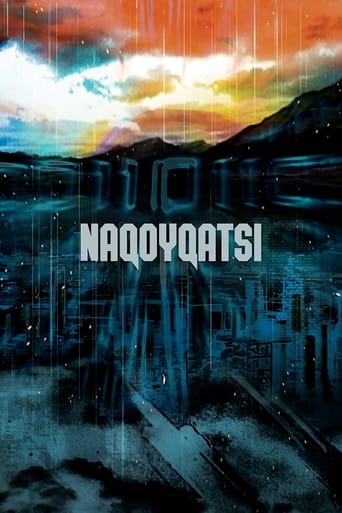Samiam3
Welcome to the digital age, a world of speed, cultural hybridity, multi media, and perceptual overload, all of which are expressed beautifully in Godfrey Reggio's third entry Naqoyquatsi. This one is vastly different from the previous two. Wheras Koyaanisqatsi and Powaquatsi were done in the real world, much of Naqoyqatsi is done on the computer. Using just about every computer graphic available at the time, Naqoyqatsi feels more like a piece of art than the other two. After deciding that Powaqatsi was a dud, I was pleased to see that Godfrey Reggio made a recovery. Naqoyqatsi is almost on par with it's fore father Koyanisquatsi, although depending on which on you see first, you may prefer this one. This one strikes me as less epic than Koyanis, in part because it's faster editing allows for much more advanced montages which are so overwhelming at times that they occasionally provoke headache.The message behind this film is the way humanity is a competitive species. I think Alfred Adler would adore this movie. One of Freud's students, he believed that the human condition is based on seeking superiority. Naqoyqatsi shows us two forms of competition. One is sporting events, and the other is physical war and fighting.Phillip Glass once again, works his musical magic, although it seems like some of the score was borrowed from Koyaanisqatsi. Together, Reggio and Glass have provided a trilogy of sights and sounds that defy all the conventions of cinema, to favour aesthetics.
leif26
Koyaanisqatsi and Powaqqatsi are both Beautiful films, but this final installment of the trilogy is a major let down. They got too carried away with stock footage and photography, so little content. The executive producer puts his own image in the film... Its just pretentious. Maybe if they had more than $3 million to spend maybe it would have been something. I actually thought Steven Soderbergh directed it because it was so bad, but Godfrey Reggio the director of Koyaanisqatsi and Powaqqatsi directed this. I'll have to assume that they just didn't have the budget to make a decent film. You would think that Francis Ford Coppola would have wanted to be a part of this film and help get more money together.
igm
The peace and beauty of Koyaanisqatsi was a powerful affirmation of the natural world. In Naqoyqatsi, we are assaulted by images of the synthetic, the competitive, the violent, and the digital -- the destructive constructs of our culture.Some liberties are taken with the images, with posterization, distressing, and much slow motion. The connections between the sequences are inscrutable, if there are any. Naqoyqatsi is defined at the film's end, a missed opportunity to place the images in context.The film is difficult to watch, the quality of the archival footage uneven, and it's most redeeming qualities are its theme and the hypnotic score of Philip Glass.
l-f-s
The film is worth a watch if you can hold on for the visual ride. A subjective plot leads you through a poignant journey of a violent and deadly future, present, and past. I found the film intriguing but visually and emotionally disturbing. The film relies on stunning visual imagery that never gives the viewer time to relax and reflect on the meaning of it all. The film is saturated with clever computer graphics. Without the use of CGI I don't believe the point of the film could have been made with as much depth as it had. The film attempts to give the viewer omnipresence over the world condition and how it got here and where it is going. At some undefined moment in the film the viewer 'gets it' but may find it difficult to put into words. The soundtrack for the film was excellent with work from Phillip Glass and Yo Yo Ma.





